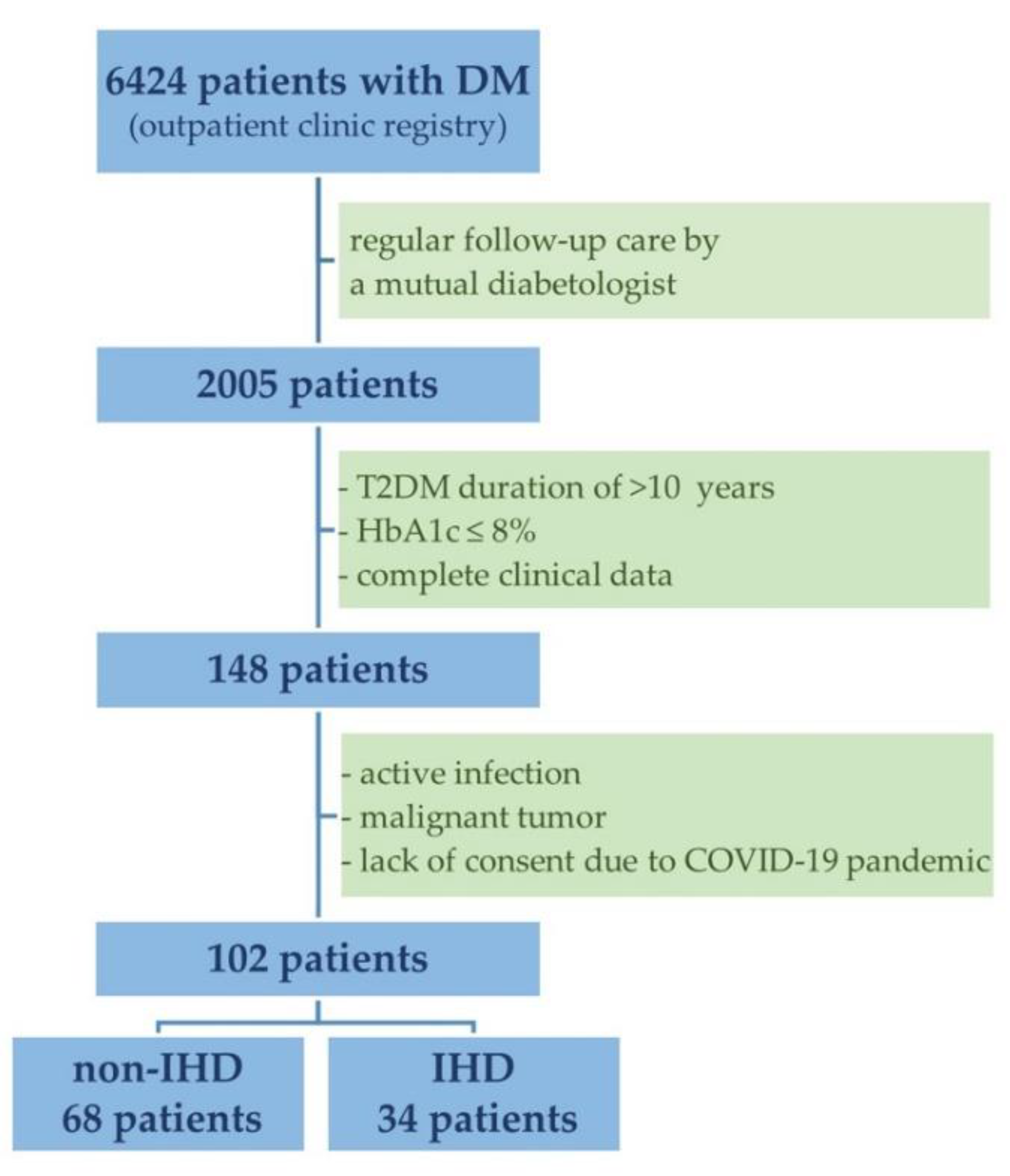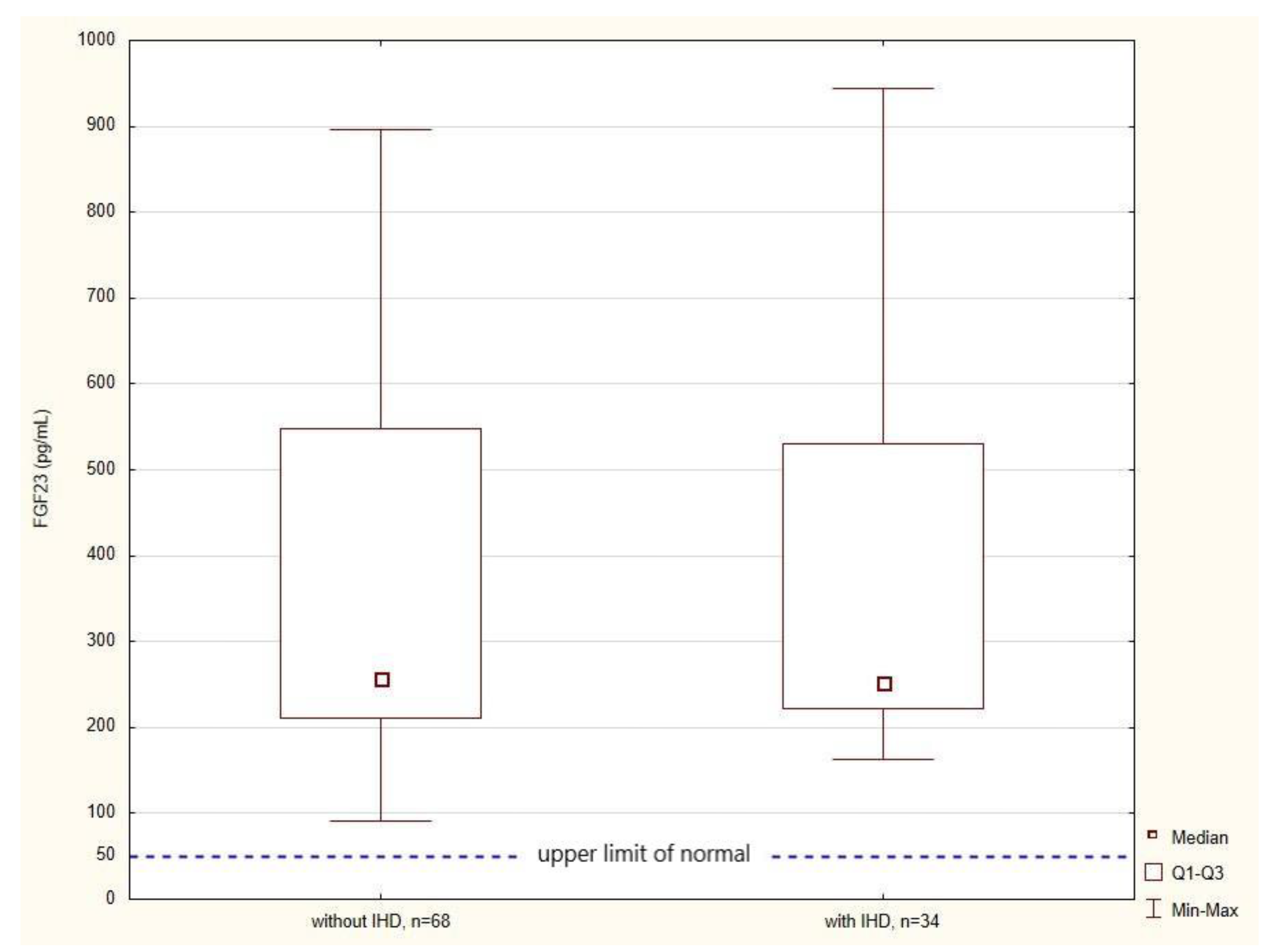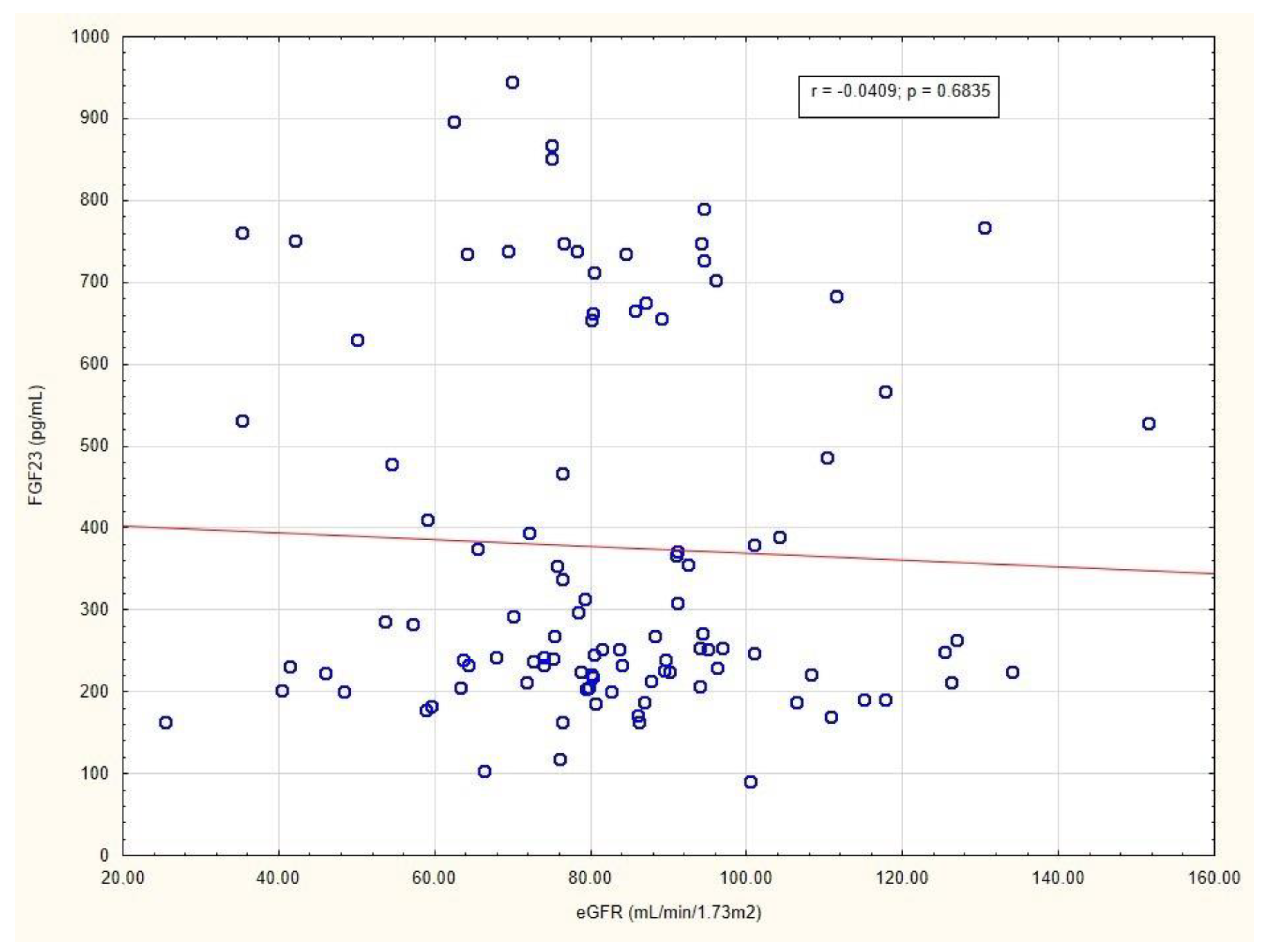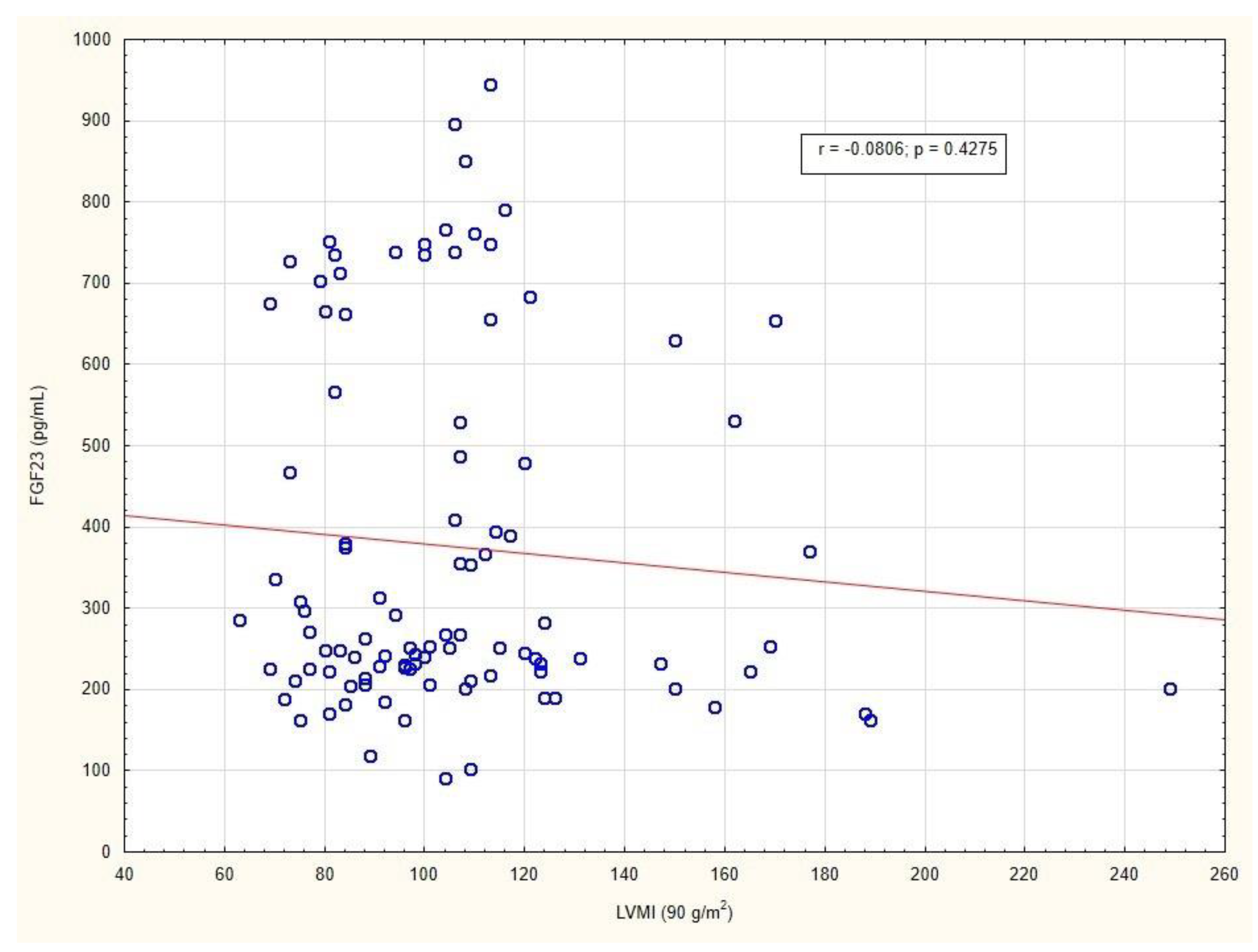Fibroblast Growth Factor 23 and Cardiovascular Risk in Diabetes Patients—Cardiologists Be Aware
Abstract
1. Introduction
2. Results
3. Discussion
4. Study Limitations
5. Materials and Methods
6. Conclusions
Supplementary Materials
Author Contributions
Funding
Institutional Review Board Statement
Informed Consent Statement
Data Availability Statement
Conflicts of Interest
References
- Martin, A.; David, V.; Quarles, L.D. Regulation and function of the FGF23/klotho endocrine pathways. Physiol. Rev. 2012, 92, 131–155. [Google Scholar] [CrossRef]
- Yamashita, T.; Yoshioka, M.; Itoh, N. Identification of a novel fibroblast growth factor, FGF-23, preferentially expressed in the ventrolateral thalamic nucleus of the brain. Biochem. Bioph. Res. Commun. 2000, 277, 494–498. [Google Scholar] [CrossRef] [PubMed]
- Quarles, L.D. FGF23, PHEX, and MEPE regulation of phosphate homeostasis and skeletal mineralization. Am. J. Physiol. Endocrinol. Metab. 2003, 285, E1–E9. [Google Scholar] [CrossRef] [PubMed]
- Strom, T.M.; Jüppner, H. PHEX, FGF23, DMP1 and beyond. Curr. Opin. Nephrol. Hypertens. 2008, 17, 357–362. [Google Scholar] [CrossRef] [PubMed]
- Lafage-Proust, M.-H. What Are the Benefits of the Anti-FGF23 Antibody Burosumab on the Manifestations of X-linked Hypophosphatemia in Adults in Comparison with Conventional Therapy? A Review. Ther. Adv. Rare Dis. 2022, 3. [Google Scholar] [CrossRef]
- Moe, S.M.; Chertow, G.M.; Parfrey, P.S.; Kubo, Y.; Block, G.A.; Correa-Rotter, R.; Drüeke, T.B.; Herzog, C.A.; London, G.M.; Mahaffey, K.W.; et al. Cinacalcet, Fibroblast Growth Factor-23, and Cardiovascular Disease in Hemodialysis: The Evaluation of Cinacalcet HCl Therapy to Lower Cardiovascular Events (EVOLVE) Trial. Circulation 2015, 132, 27–39. [Google Scholar] [CrossRef]
- Yamazaki, Y.; Tamada, T.; Kasai, N.; Urakawa, I.; Aono, Y.; Hasegawa, H.; Fujita, T.; Kuroki, R.; Yamashita, T.; Fukumoto, S.; et al. Anti-FGF23 neutralizing antibodies show the physiological role and structural features of FGF23. J. Bone Miner. Res. 2008, 23, 1509–1518. [Google Scholar] [CrossRef]
- Wolf, M. Update on fibroblast growth factor 23 in chronic kidney disease. Kidney Int. 2012, 82, 737–747. [Google Scholar] [CrossRef]
- Isakova, T.; Wahl, P.; Vargas, G.S.; Gutiérrez, O.M.; Scialla, J.; Xie, H.; Appleby, D.; Nessel, L.; Bellovich, K.; Chen, J.; et al. Fibroblast growth factor 23 is elevated before parathyroid hormone and phosphate in chronic kidney disease. Kidney Int. 2011, 79, 1370–1378. [Google Scholar] [CrossRef]
- Ditzel, J.; Lervang, H.H. Disturbance of inorganic phosphate metabolism in diabetes mellitus: Temporary therapeutic intervention trials. Diabetes Metab. Syndr. Obes. 2009, 2, 173–177. [Google Scholar]
- Giachelli, C.M. The emerging role of phosphate in vascular calcification. Kidney Int. 2009, 75, 890–897. [Google Scholar] [CrossRef] [PubMed]
- Ghosh, S.; Luo, D.; He, W.; Chen, J.; Su, X.; Huang, H. Diabetes and calcification: The potential role of anti-diabetic drugs on vascular calcification regression. Pharmacol. Res. 2020, 158, 104861. [Google Scholar] [CrossRef] [PubMed]
- Roth, G.A.; Mensah, G.A.; Johnson, C.O.; Addolorato, G.; Ammirati, E.; Baddour, L.M.; Barengo, N.C.; Beaton, A.Z.; Benjamin, E.J.; Benziger, C.P.; et al. Global Burden of Cardiovascular Diseases and Risk Factors, 1990-2019: Update from the GBD 2019 Study. J. Am. Coll. Cardiol. 2020, 76, 2982–3021. [Google Scholar] [CrossRef] [PubMed]
- Emerging Risk Factors Collaboration; Sarwar, N.; Gao, P.; Seshasai, S.R.; Gobin, R.; Kaptoge, S.; Di Angelantonio, E.; Ingelsson, E.; Lawlor, D.A.; Selvin, E.; et al. Diabetes mellitus, fasting blood glucose concentration, and risk of vascular disease: A collaborative meta-analysis of 102 prospective studies. Lancet 2010, 375, 2215–2222. [Google Scholar] [CrossRef]
- Yamazaki, Y.; Okazaki, R.; Shibata, M.; Hasegawa, Y.; Satoh, K.; Tajima, T.; Takeuchi, Y.; Fujita, T.; Nakahara, K.; Yamashita, T.; et al. Increased circulatory level of biologically active full-length FGF-23 in patients with hypophosphatemic rickets/osteomalacia. J. Clin. Endocrinol. Metab. 2002, 87, 4957–4960. [Google Scholar] [CrossRef]
- Severino, P.; D’Amato, A.; Pucci, M.; Infusino, F.; Birtolo, L.I.; Mariani, M.V.; Lavalle, C.; Maestrini, V.; Mancone, M.; Fedele, F. Ischemic Heart Disease and Heart Failure: Role of Coronary Ion Channels. Int. J. Mol. Sci. 2020, 21, 3167. [Google Scholar] [CrossRef]
- Hartley, A.; Marshall, D.C.; Salciccioli, J.D.; Sikkel, M.B.; Maruthappu, M.; Shalhoub, J. Trends in mortality from ischemic heart disease and cerebrovascular disease in Europe: 1980 to 2009. Circulation 2016, 133, 1916–1926. [Google Scholar] [CrossRef]
- Khan, M.A.; Hashim, M.J.; Mustafa, H.; Baniyas, M.Y.; Al Suwaidi, S.K.B.M.; AlKatheeri, R.; Alblooshi, F.M.K.; Almatrooshi, M.E.A.H.; Alzaabi, M.E.H.; Al Darmaki, R.S.; et al. Global Epidemiology of Ischemic Heart Disease: Results from the Global Burden of Disease Study. Cureus 2020, 12, e9349. [Google Scholar] [CrossRef]
- Liu, S.; Li, Y.; Zeng, X.; Wang, H.; Yin, P.; Wang, L.; Liu, Y.; Liu, J.; Qi, J.; Ran, S.; et al. Burden of cardiovascular diseases in China, 1990–2016: Findings from the 2016 Global Burden of Disease Study. JAMA Cardiol. 2019, 4, 342–352. [Google Scholar] [CrossRef]
- Brown, J.C.; Gerhardt, T.E.; Kwon, E. Risk Factors For Coronary Artery Disease; StatPearls Publishing: Treasure Island, FL, USA, 2021. [Google Scholar]
- Dhingra, R.; Vasan, R.S. Age as a risk factor. Med. Clin. N. Am. 2012, 96, 87–91. [Google Scholar] [CrossRef]
- Maas, A.; Appelman, Y. Gender differences in coronary heart disease. Neth. Heart J. 2010, 18, 598–603. [Google Scholar] [CrossRef] [PubMed]
- Weintraub, W.S.; Daniels, S.R.; Burke, L.E.; Franklinz, B.A.; Goff, D.C., Jr.; Hayman, L.L.; Lloyd-Jones, D.; Pandey, D.K.; Sanchez, E.J.; Schram, A.P.; et al. Value of primordial and primary prevention for cardiovascular disease: A policy statement from the American Heart Association. Circulation 2011, 124, 967–990. [Google Scholar] [CrossRef] [PubMed]
- ADHR Consortium. Autosomal Dominant Hypophosphataemic Rickets Is Associated with Mutations in FGF23. Nat. Genet. 2000, 26, 345–348. [Google Scholar] [CrossRef] [PubMed]
- Isakova, T.; Ix, J.H.; Sprague, S.M.; Raphael, K.L.; Fried, L.; Gassman, J.J.; Raj, D.; Cheung, A.K.; Kusek, J.W.; Flessner, M.F.; et al. Rationale and Approaches to Phosphate and Fibroblast Growth Factor 23 Reduction in CKD. J. Am. Soc. Nephrol. 2015, 26, 2328–2339. [Google Scholar] [CrossRef]
- Smith, E.R. The use of fibroblast growth factor 23 testing in patients with kidney disease. Cliny. J. Am. Soc. Nephrol. 2014, 9, 1283–1303. [Google Scholar] [CrossRef]
- Kestenbaum, B.; Sachs, M.C.; Hoofnagle, A.N.; Siscovick, D.S.; Ix, J.H.; Robinson-Cohen, C.; Lima, J.A.; Polak, J.F.; Blondon, M.; Ruzinski, J.; et al. Fibroblast growth factor-23 and cardiovascular disease in the general population: The Multi-Ethnic Study of Atherosclerosis. Circ. Heart Fail. 2014, 7, 409–417. [Google Scholar] [CrossRef]
- Udell, J.A.; Morrow, D.A.; Jarolim, P.; Sloan, S.; Hoffman, E.B.; O’Donnell, T.F.; Vora, A.N.; Omland, T.; Solomon, S.D.; Pfeffer, M.A.; et al. Fibroblast growth factor-23, cardiovascular prognosis, and benefit of angiotensin-converting enzyme inhibition in stable ischemic heart disease. J. Am. Coll. Cardiol. 2014, 63, 2421–2428. [Google Scholar] [CrossRef]
- Brandenburg, V.M.; Kleber, M.E.; Vervloet, M.G.; Tomaschitz, A.; Pilz, S.; Stojakovic, T.; Delgado, G.; Grammar, T.B.; Marx, N.; März, W.; et al. Fibroblast growth factor 23 (FGF23) and mortality: The Ludwigshafen Risk and Cardiovascular Health Study. Atherosclerosis 2014, 237, 53–59. [Google Scholar] [CrossRef]
- Cornelissen, A.; Florescu, R.; Kneizeh, K.; Cornelissen, C.; Liehn, E.; Brandenburg, V.; Schuh, A. Fibroblast Growth Factor 23 and Outcome Prediction in Patients with Acute Myocardial Infarction. J. Clin. Med. 2022, 11, 601. [Google Scholar] [CrossRef]
- Thorsen, I.S.; Gøransson, L.G.; Ueland, T.; Aukrust, P.; Manhenke, C.A.; Skadberg, Ø.; Jonsson, G.; Ørn, S. The relationship between Fibroblast Growth Factor 23 (FGF23) and cardiac MRI findings following primary PCI in patients with acute first time STEMI. Int. J. Cardiol. Heart Vasc. 2021, 33, 100727. [Google Scholar] [CrossRef]
- Shibata, K.; Fujita, S.; Morita, H.; Okamoto, Y.; Sohmiya, K.; Hoshiga, M.; Ishizaka, N. Association between circulating fibroblast growth factor 23, α-Klotho, and the left ventricular ejection fraction and left ventricular mass in cardiology inpatients. PLoS ONE 2013, 8, e73184. [Google Scholar] [CrossRef]
- Bridges, M.J.; Moochhala, S.H.; Barbour, J.; Kelly, C.A. Influence of diabetes on peripheral bone mineral density in men: A controlled study. Acta Diabetol. 2005, 42, 82–86. [Google Scholar] [CrossRef]
- Vestergaard, P.; Rejnmark, L.; Mosekilde, L. Diabetes and its complications and their relationship with risk of fractures in type 1 and 2 diabetes. Calcif. Tissue Int. 2009, 84, 45–55. [Google Scholar] [CrossRef]
- Ma, L.; Oei, L.; Jiang, L.; Estrada, K.; Chen, H.; Wang, Z.; Yu, Q.; Zillikens, M.C.; Gao, X.; Rivadeneira, F. Association between bone mineral density and type 2 diabetes mellitus: A meta-analysis of observational studies. Eur. J. Epidemiol. 2012, 27, 319–332. [Google Scholar] [CrossRef] [PubMed]
- Shanbhogue, V.V.; Hansen, S.; Frost, M.; Brixen, K.; Hermann, A.P. Bone disease in diabetes: Another manifestation of microvascular disease? Lancet Diabetes Endocrinol. 2017, 5, 827–838. [Google Scholar] [CrossRef]
- Wahl, P.; Xie, H.; Scialla, J.; Anderson, C.A.; Bellovich, K.; Brecklin, C.; Chen, J.; Feldman, H.; Gutierrez, O.M.; Lash, J.; et al. Earlier onset and greater severity of disordered mineral metabolism in diabetic patients with chronic kidney disease. Diabetes Care 2012, 35, 994–1001. [Google Scholar] [CrossRef] [PubMed]
- Tuñón, J.; Fernández-Fernández, B.; Carda, R.; Pello, A.M.; Cristóbal, C.; Tarín, N.; Aceña, Á.; González-Casaus, M.L.; Huelmos, A.; Alonso, J.; et al. Circulating fibroblast growth factor-23 plasma levels predict adverse cardiovascular outcomes in patients with diabetes mellitus with coronary artery disease. Diabetes Metab. Res. Rev. 2016, 32, 685–693. [Google Scholar] [CrossRef]
- Yeung, S.M.H.; Binnenmars, S.H.; Gant, C.M.; Navis, G.; Gansevoort, R.T.; Bakker, S.J.L.; de Borst, M.H.; Laverman, G.D. Fibroblast Growth Factor 23 and Mortality in Patients with Type 2 Diabetes and Normal or Mildly Impaired Kidney Function. Diabetes Care 2019, 42, 2151–2153. [Google Scholar] [CrossRef]
- Simic, P.; Kim, W.; Zhou, W.; Pierce, K.A.; Chang, W.; Sykes, D.B.; Aziz, N.B.; Elmariah, S.; Ngo, D.; Pajevic, P.D.; et al. Glycerol-3-phosphate is an FGF23 regulator derived from the injured kidney. J. Clin. Investig. 2020, 130, 1513–1526. [Google Scholar] [CrossRef]
- Giroix, M.H.; Rasschaert, J.; Bailbe, D.; Leclercq-Meyer, V.; Sener, A.; Portha, B.; Malaisse, W.J. Impairment of glycerol phosphate shuttle in islets from rats with diabetes induced by neonatal streptozocin. Diabetes 1991, 40, 227–232. [Google Scholar] [CrossRef]
- Samadfam, R.; Richard, C.; Nguyen-Yamamoto, L.; Bolivar, I.; Goltzman, D. Bone formation regulates circulating concentrations of fibroblast growth factor 23. Endocrinology 2009, 150, 4835–4845. [Google Scholar] [CrossRef] [PubMed][Green Version]
- Anders, H.J.; Huber, T.B.; Isermann, B.; Schiffer, M. CKD in diabetes: Diabetic kidney disease versus nondiabetic kidney disease. Nat. Rev. Nephrol. 2018, 14, 361–377. [Google Scholar] [CrossRef]
- Yamamoto, M.; Sugimoto, T. Advanced Glycation End Products, Diabetes, and Bone Strength. Curr. Osteoporos. Rep. 2016, 14, 320–326. [Google Scholar] [CrossRef] [PubMed]
- Bär, L.; Wächter, K.; Wege, N.; Navarrete Santos, A.; Simm, A.; Föller, M. Advanced Glycation End Products Stimulate Gene Expression of Fibroblast Growth Factor 23. Mol. Nutr. Food Res. 2017, 61, 1601019. [Google Scholar] [CrossRef] [PubMed]
- David, V.; Martin, A.; Isakova, T.; Spaulding, C.; Qi, L.; Ramirez, V.; Zumbrennen-Bullough, K.B.; Sun, C.C.; Lin, H.Y.; Babitt, J.L.; et al. Inflammation and functional iron deficiency regulate fibroblast growth factor 23 production. Kidney Int. 2016, 89, 135–146. [Google Scholar] [CrossRef]
- Donath, M.Y.; Shoelson, S.E. Type 2 diabetes as an inflammatory disease. Nat. Rev. Immunol. 2011, 11, 98–107. [Google Scholar] [CrossRef]
- Zinman, B.; Wanner, C.; Lachin, J.M.; Fitchett, D.; Bluhmki, E.; Hantel, S.; Mattheus, M.; Devins, T.; Johansen, O.E.; Woerle, H.J.; et al. Empagliflozin, Cardiovascular Outcomes, and Mortality in Type 2 Diabetes. N. Engl. J. Med. 2015, 373, 2117–2128. [Google Scholar] [CrossRef]
- Wanner, C.; Inzucchi, S.E.; Lachin, J.M.; Fitchett, D.; von Eynatten, M.; Mattheus, M.; Johansen, O.E.; Woerle, H.J.; Broedl, U.C.; Zinman, B. Empagliflozin and Progression of Kidney Disease in Type 2 Diabetes. N. Engl. J. Med. 2016, 375, 323–334. [Google Scholar] [CrossRef]
- Neal, B.; Perkovic, V.; Mahaffey, K.W.; de Zeeuw, D.; Fulcher, G.; Erondu, N.; Shaw, W.; Law, G.; Desai, M.; Matthews, D.R. Canagliflozin and Cardiovascular and Renal Events in Type 2 Diabetes. N. Engl. J. Med. 2017, 377, 644–657. [Google Scholar] [CrossRef]
- Wiviott, S.D.; Raz, I.; Bonaca, M.P.; Mosenzon, O.; Kato, E.T.; Cahn, A.; Silverman, M.G.; Zelniker, T.A.; Kuder, J.F.; Murphy, S.A.; et al. Dapagliflozin and Cardiovascular Outcomes in Type 2 Diabetes. N. Engl. J. Med. 2019, 380, 347–357. [Google Scholar] [CrossRef]
- Heerspink, H.J.L.; Stefánsson, B.V.; Correa-Rotter, R.; Chertow, G.M.; Greene, T.; Hou, F.F.; Mann, J.F.E.; McMurray, J.J.V.; Lindberg, M.; Rossing, P.; et al. Dapagliflozin in Patients with Chronic Kidney Disease. N. Engl. J. Med. 2020, 383, 1436–1446. [Google Scholar] [CrossRef] [PubMed]
- De Jong, M.A.; Petrykiv, S.I.; Laverman, G.D.; van Herwaarden, A.E.; de Zeeuw, D.; Bakker, S.J.L.; Heerspink, H.J.L.; de Borst, M.H. Effects of Dapagliflozin on Circulating Markers of Phosphate Homeostasis. Clin. J. Am. Soc. Nephrol. 2019, 14, 66–73. [Google Scholar] [CrossRef] [PubMed]
- Blau, J.E.; Bauman, V.; Conway, E.M.; Piaggi, P.; Walter, M.F.; Wright, E.C.; Bernstein, S.; Courville, A.B.; Collins, M.T.; Rother, K.I.; et al. Canagliflozin triggers the FGF23/1,25-dihydroxyvitamin D/PTH axis in healthy volunteers in a randomized crossover study. J. CI Insight. 2018, 3, e99123. [Google Scholar] [CrossRef]
- Barrett, P.Q.; Aronson, P.S. Glucose and alanine inhibition of phosphate transport in renal microvillus membrane vesicles. Am. J. Physiol. Physiol. 1982, 242, F126–F131. [Google Scholar] [CrossRef]
- Bär, L.; Feger, M.; Fajol, A.; Klotz, L.O.; Zeng, S.; Lang, F.; Hocher, B.; Föller, M. Insulin Suppresses the Production of fibroblast growth factor 23 (FGF23). Proc. Nat. Acad. Sci. USA 2018, 115, 5804–5809. [Google Scholar] [CrossRef] [PubMed]






| Variable | Total N = 102 | Without IHD N = 68 | With IHD N = 34 | p Value |
|---|---|---|---|---|
| Age, years | 69 (66–74) | 69 (66–74) | 70 (68–74) | 0.420 |
| Female sex | 43 (42) | 34 (33) | 9 (9) | 0.024 |
| T2DM duration, years | 19 (14–25) | 18 (13–24) | 22 (16–27) | 0.182 |
| Fasting blood glucose, mg/dL | 120 (110–130) | 120 (110–130) | 130 (110–140) | 0.396 |
| Postprandial blood glucose, mg/dL | 150 (130–170) | 140 (120–170) | 150 (140–160) | 0.238 |
| BMI, kg/m2 | 28 (25–32) | 29 (25–33) | 27 (26–32) | 0.337 |
| Arterial hypertension | 88 (86) | 54 (53) | 34 (33) | 0.044 |
| Myocardial infarction | 29 (28) | 0 | 29 (28) | 0.000 |
| CABG | 9 (9) | 0 | 9 (9) | 0.000 |
| Stroke | 9 (9) | 5 (5) | 4 (4) | 0.711 |
| Atrial fibrillation | 11 (11) | 3 (3) | 8 (8) | 0.094 |
| Diabetic retinopathy | 20 (20) | 10 (10) | 10 (10) | 0.077 |
| Diabetic neuropathy | 12 (12) | 7 (7) | 5 (5) | 0.514 |
| Diabetic foot syndrome | 5 (5) | 2 (2) | 3 (3) | 0.417 |
| Family history of heart disease | 51 (50) | 34 (33) | 17 (17) | 1.0 |
| Family history of diabetes mellitus | 64 (63) | 44 (43) | 20 (20) | 0.562 |
| Current and former smokers | 75 (74) | 46 (45) | 29 (29) | 0.095 |
| Non-smokers | 27 (26) | 22 (21) | 5 (5) | 0.095 |
| Variable | Total N = 102 | Without IHD N = 68 | With IHD N = 34 | p-Value |
|---|---|---|---|---|
| FGF23, pg/mL | 253 (218–531) | 258 (212–548) | 253 (222–531) | 0.861 |
| Cr, mg/dL | 0.86 (0.75–1.0) | 0.815 (0.73–0.95) | 0.93 (0.84–1.27) | 0.002 |
| eGFR, mL/min/1.73 m2 | 80 (70–94) | 84 (74–95) | 79 (55–90) | 0.035 |
| HbA1c, % | 6.85 (6.5–7.7) | 6.85 (6.35–7.5) | 6.85 (6.5–7.8) | 0.422 |
| TC, mg/dL | 152 (125–186) | 157 (128–194) | 134 (124–178) | 0.226 |
| HDL-C, mg/dL | 49 (42–59) | 51 (43–62) | 44 (41–53) | 0.029 |
| LDL-C, mg/dL | 72 (51–98) | 76 (53–100) | 66 (48–98) | 0.424 |
| non-HDL-C, mg/dL | 96 (75–126) | 104 (75–126) | 91 (78–127) | 0.677 |
| TG, mg/dL | 126 (94–169) | 122 (89–169) | 131 (105–173) | 0.244 |
| Variable | Total N = 102 | Without IHD N = 68 | With IHD N = 34 | p-Value |
|---|---|---|---|---|
| LVEF, % | 56 (52–60) | 56 (54–61) | 55 (52–60) | 0.038 |
| LVESV, mL | 32 (29–36) | 31 (28–35) | 36 (29–39) | 0.007 |
| LVEDV, mL | 46 (43–50) | 45 (43–48) | 48 (45–53) | 0.009 |
| LVMI, g/m2 | 101 (84–115) | 97 (83–108) | 113 (91–131) | 0.004 |
| LA volume, mL | 56 (44–75) | 50 (42–63) | 68 (56–83) | 0.0002 |
| LAVI, mL/m2 | 29 (23–37) | 26 (22–33) | 33 (30–42) | 0.0003 |
| TAPSE, mm | 22 (19–24) | 22 (20–25) | 20 (18–23) | 0.008 |
| RVOT proximal diameter, mm | 33 (30–35) | 32 (30–34) | 34 (30–36) | 0.067 |
| IVSs, mm | 16 (15–17) | 16 (15–17) | 17 (14–18) | 0.342 |
| IVSd, mm | 11 (10–13) | 11 (10–12) | 12 (11–14) | 0.098 |
| Class | Patients Taking Medication | FGF23 Concentration | p Value | |
|---|---|---|---|---|
| Taking Medication | Not Taking Medication | |||
| Biguanide | 83 (82) | 253 (218–529) | 356 (212–713) | 0.525 |
| Sulphonylureas | 28 (28) | 260 (224–669) | 253 (214–479) | 0.474 |
| Thiazolidinediones | 4 (4) | 291 (223–590) | 253 (218–531) | 0.743 |
| α-glucosidase inhibitors | 12 (12) | 315 (231–659) | 253 (214–487) | 0.520 |
| SGLT-2 inhibitors | 24 (24) | 256 (204–364) | 253 (222–655) | 0.280 |
| DPP-4 inhibitors | 13 (13) | 487 (268–727) | 252 (214–467) | 0.086 |
| GLP-1 agonists | 1 (1) | 867 (867–867) | 253 (218–529) | 1.000 |
| Insulins | 47 (46) | 268 (222–531) | 252 (206–656) | 0.535 |
Publisher’s Note: MDPI stays neutral with regard to jurisdictional claims in published maps and institutional affiliations. |
© 2022 by the authors. Licensee MDPI, Basel, Switzerland. This article is an open access article distributed under the terms and conditions of the Creative Commons Attribution (CC BY) license (https://creativecommons.org/licenses/by/4.0/).
Share and Cite
Kurpas, A.; Supel, K.; Wieczorkiewicz, P.; Bodalska Duleba, J.; Zielinska, M. Fibroblast Growth Factor 23 and Cardiovascular Risk in Diabetes Patients—Cardiologists Be Aware. Metabolites 2022, 12, 498. https://doi.org/10.3390/metabo12060498
Kurpas A, Supel K, Wieczorkiewicz P, Bodalska Duleba J, Zielinska M. Fibroblast Growth Factor 23 and Cardiovascular Risk in Diabetes Patients—Cardiologists Be Aware. Metabolites. 2022; 12(6):498. https://doi.org/10.3390/metabo12060498
Chicago/Turabian StyleKurpas, Anna, Karolina Supel, Paulina Wieczorkiewicz, Joanna Bodalska Duleba, and Marzenna Zielinska. 2022. "Fibroblast Growth Factor 23 and Cardiovascular Risk in Diabetes Patients—Cardiologists Be Aware" Metabolites 12, no. 6: 498. https://doi.org/10.3390/metabo12060498
APA StyleKurpas, A., Supel, K., Wieczorkiewicz, P., Bodalska Duleba, J., & Zielinska, M. (2022). Fibroblast Growth Factor 23 and Cardiovascular Risk in Diabetes Patients—Cardiologists Be Aware. Metabolites, 12(6), 498. https://doi.org/10.3390/metabo12060498






